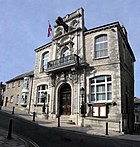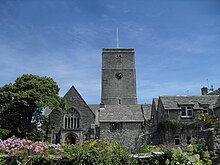Swanage
| Swanage | |||
|---|---|---|---|
|
|||
| Coordinates | 50 ° 37 ′ N , 1 ° 58 ′ W | ||
|
|
|||
| Residents | 10.124 | ||
| administration | |||
| Post town | SWANAGE | ||
| ZIP code section | BH19 | ||
| prefix | 01929 | ||
| Part of the country | England | ||
| region | South West England | ||
| Ceremonial county | Dorset | ||
| Unitary authority | Dorset | ||
| ONS code | 00HN | ||
| Website: www.swanage.gov.uk | |||
Swanage is a coastal town in the county of Dorset , on the south coast of England . Swanage is located at the eastern end of the Isle of Purbeck peninsula , about 10 kilometers south of Poole and Bournemouth and about 40 kilometers southeast of Dorchester . Dorchester is the administrative seat of the county. The city of Swanage has 10,124 inhabitants (as of 2001). The main route is the A351 road from Lytchett Minster via Wareham to Swanage.
location
Throughout history the bay has been called Swanawic, Swanwich, or Sandwich; only in recent Swanage history.
The village was a small port and fishing village. In the Victorian Age , a large port was built for shipping the Purbeck stone and Purbeck marble for the quarries that are along the cliffs to the south.
Swanage remains one of the most popular English seaside resorts. Due to its geographical location, Swanage has a very mild climate and is considered the sunniest place in England. Today (2010) tourism is the most important branch of the economy employing many people who live in the city. Currently 40% of the workforce commute from Swanage to Poole.
Swanage lies between mountain landscapes, limestone cliffs, sea bays and the long, east-facing sandy beach. Close to Swanage are Ballard Down , Old Harry Rocks and Studland Bay and Poole Harbor , to the north Durlston Bay and Durlston Country Park to the south. Swanage is located on the eastern end of the Jurassic Coast , a stretch of coast that is counted among the natural wonders of the world, was the first natural landscape in England to be declared a World Heritage Site by UNESCO and is known for its fossils .
history
Until the 19th century
Fishing is probably the oldest trade in the region. The quarries were and are an important industry of the city and the surrounding area since the 1st century AD During the period of Roman occupation, the quarries of the distinctive Purbeck marble developed for decorative purposes in buildings that were used far away such as London. When the Romans left Britain, the quarry operations largely ceased until the 12th century.
The village is first mentioned in an entry in the Anglo-Saxon Chronicle for the year 877 as Swanwich. There it is named as the scene of a great naval victory by King Alfred over the Danes.
In the 12th century, the demand for Purbeck marble increased again. Purbeck marble is not weather-resistant and especially suitable for decorative purposes and was mainly used for interior columns. The marble was used to build many large churches and cathedrals in the interior. In contrast to Purbeck marble, Purbeck limestone has been used on site as a building block since the early days of the quarry. The development of modern quarrying techniques in the 17th century led to a further increase in stone production.
Victorian era
The idea of making Swanage a tourist destination was promoted by a member of parliament in the early 19th century, William Morton Pitt. This one came from Swanage.
John Mowlem (1788–1868) and his nephew George Burt (1816–1894), both from Swanage, became successful building contractors in London. With the use of natural stone, including the Purbeck Limestone, across England, their businesses grew positively and many of London's building blocks and monuments came from Swanage. The natural stones were loaded as ballast into the empty ships that transported the Purbeck stone to London.
One of the large bell towers near Peveril Point is made from the local rock. The clock tower commemorating Arthur Wellesley, 1st Duke of Wellington was designed by Arthur Ashpital and built in 1854 at the south end of the old London Bridge . In just ten years it became a traffic obstruction and had to be removed. 1867-68 it was rebuilt at the southern end of Swanage Bay, the current location. Another structural element that was transported to Swanage from London is the facade of Mercers' Hall (dismantled in 1860) and used as the facade of Swanage Town Hall. The original pier in the harbor was built between 1859 and 1860 and was primarily used by the local quarrying companies. Construction of the new pier began in 1895 and was officially opened to shipping in 1897.
Both John Mowlem and George Burt successfully influenced the development of the city as they built most of the city's infrastructure. You were responsible for the first gas and water works. The Purbeck House was built in 1875. George Burt was the architect of this house. There are also numerous artifacts from London that he has acquired on the 3.5 hectare property. George Burt developed the Durlston Landhold and Country Park. The Great Globe , located in Durlston Country Park, was built by George Burt in London in 1887. It measures three meters in diameter, weighs 40 tons and is made up of 15 parts. It is located on the rock 40 meters above sea level.
The Swanage Lighthouse was built on the rock at Anvil Point in 1880 . The railroad continued to Swanage in 1885. The Grand Hotel dates back to 1898.
20th century
The city was a successful seaside resort for several decades. The First World War did not cause any destruction in the city and during the Second World War several gun emplacements and bunkers were built. The city suffered bomb damage during World War II and 20 people were killed. The town and other nearby villages played a huge role in the development of radar during World War II.
After the Second World War, the city suffered from the economic recession and few people had the money to spend on vacation. In January 1972 the Swanage railway branch line was closed by British Rail. A group of local enthusiasts formed a non-profit organization for the maintenance of the railway line with steam and diesel locomotives, which in May 1972 founded the company Swanage Railway.
Swanage has suffered numerous floods, most recently in 1990. In 1993, a major construction project was completed to reduce the damage caused by the floods. This structure ends at the "new jetty" in the middle of the beach to allow the rainwater to drain away.
administration
The local parish of Swanage is divided as follows: Swanage Town Council , the Purbeck District Council (administrative seat in Wareham) and the Dorset County Council (administrative seat in Dorchester). In the National Parliament Swanage is represented as part of the constituency of South Dorset
geology
The geology around Swanage is very diverse. The Isle of Purbeck has two coasts and along the south coast the geology is very simple, while along the east coast it is very complex.
- see main article Isle of Purbeck
economy
The main industry in Swanage is tourism, which employs a large number of the working population. However, as with most tourist centers, the demand in Swanage is highly seasonal. Workers looking for permanent jobs commute to the nearby towns of Bournemouth and Poole.
The center has a number of major retail outlets and a number of local retailers. Swanage also has a few cafes, bars, restaurants, pubs and a club. There are two arcades and several ice cream outlets near the beach. The city also has a number of successful small craft shops, including a chocolatier .
On the outskirts of town is a valley brickworks that uses Whealdon clay to make bricks. The Isle of Purbeck has a long history of quarrying and quarries are operated in the south of the town.
tourism
During the high season, in summer, many people are attracted to the historical backdrop, the city, the beach and the other attractions. The city has a large number of hotels and bed and breakfasts. The number (especially hotels) has decreased in recent years.
Swanage has a gently sloping white sandy beach that is protected and the sea is usually very calm. The beach is served by the local companies and service providers. For example there are many ice cream outlets, fish restaurants, fish and chip shops, cafes and bars. You can rent deck chairs, boats, pedal boats and general water sports equipment. There are arcades and parks.
In addition to the beach, there are other local attractions like the restored Swanage Steam Railway and the Victorian Pier. The city is also used as a base from which to visit other nearby places and bays, such as places like Corfe Castle , Dorchester and Maiden Castle , Brownsea Island and Poole Harbor .
See also
List of places along the Jurassic Coast
Web links
Individual evidence
- ^ Anglo-Saxon Chronicle: AD 877. This year the Danish army came into Exeter from Wareham; whilst the navy sailed west about, until they met with a great mist at sea, and there perished one hundred and twenty ships at Swanwich. (see online edition of the chronicle)






